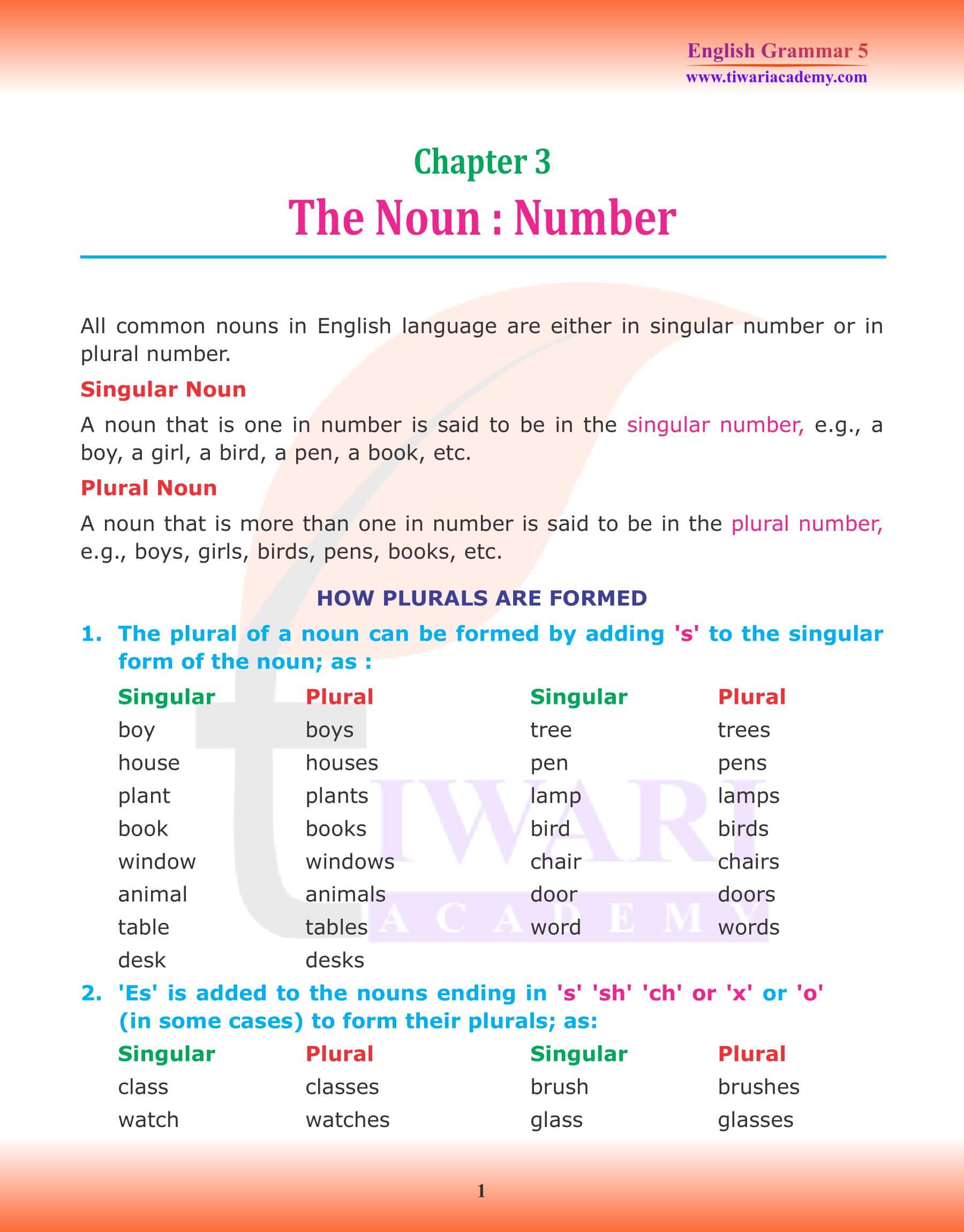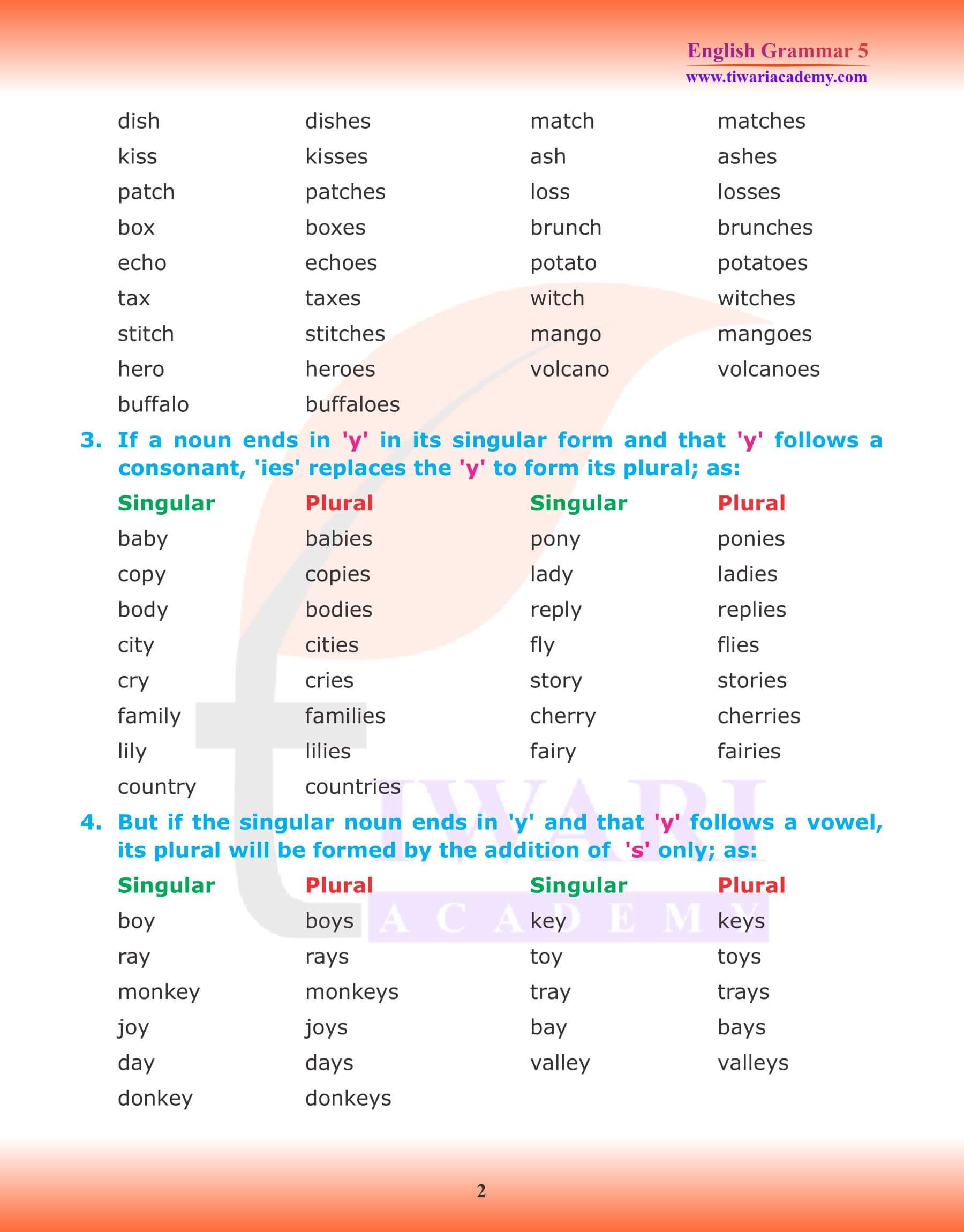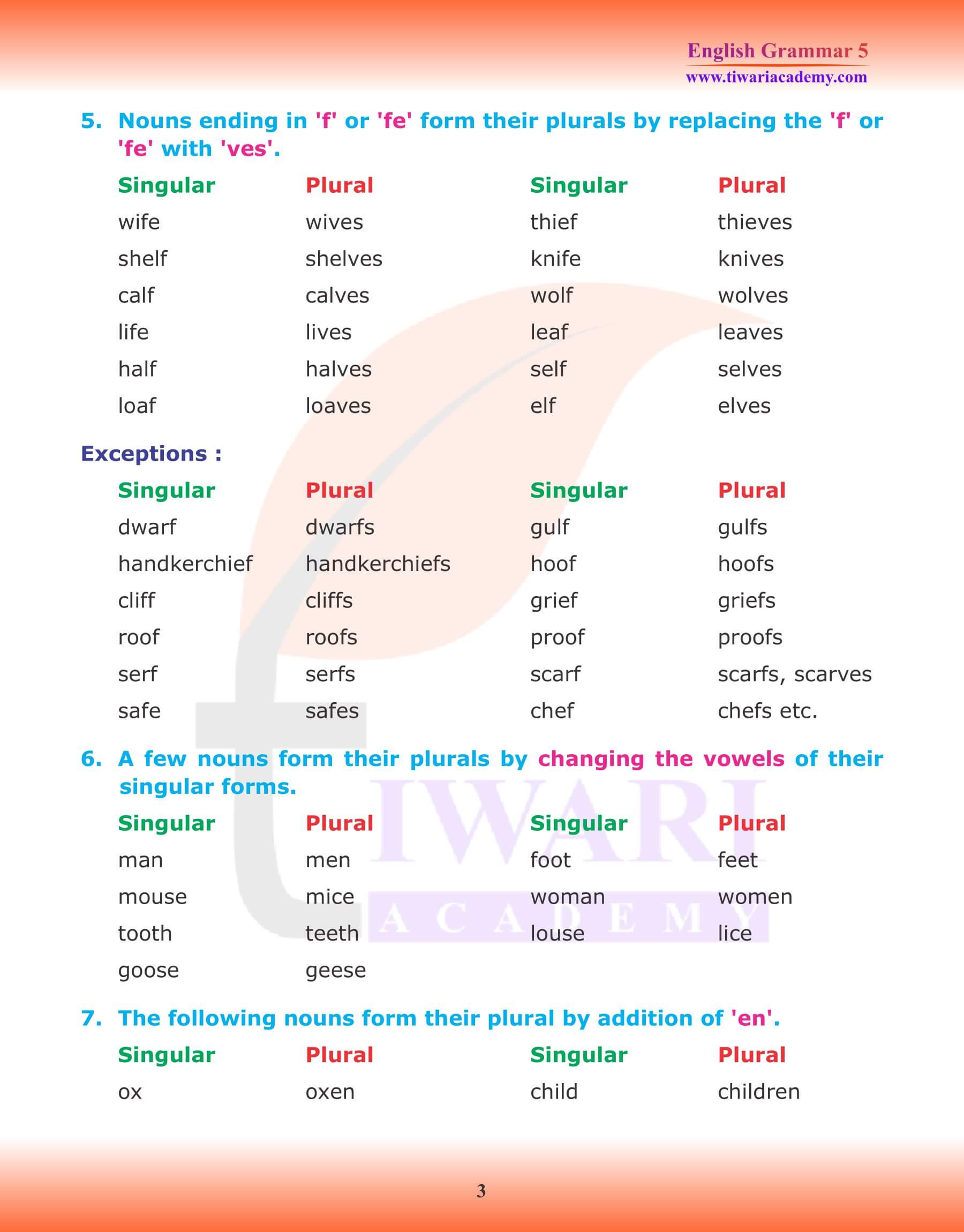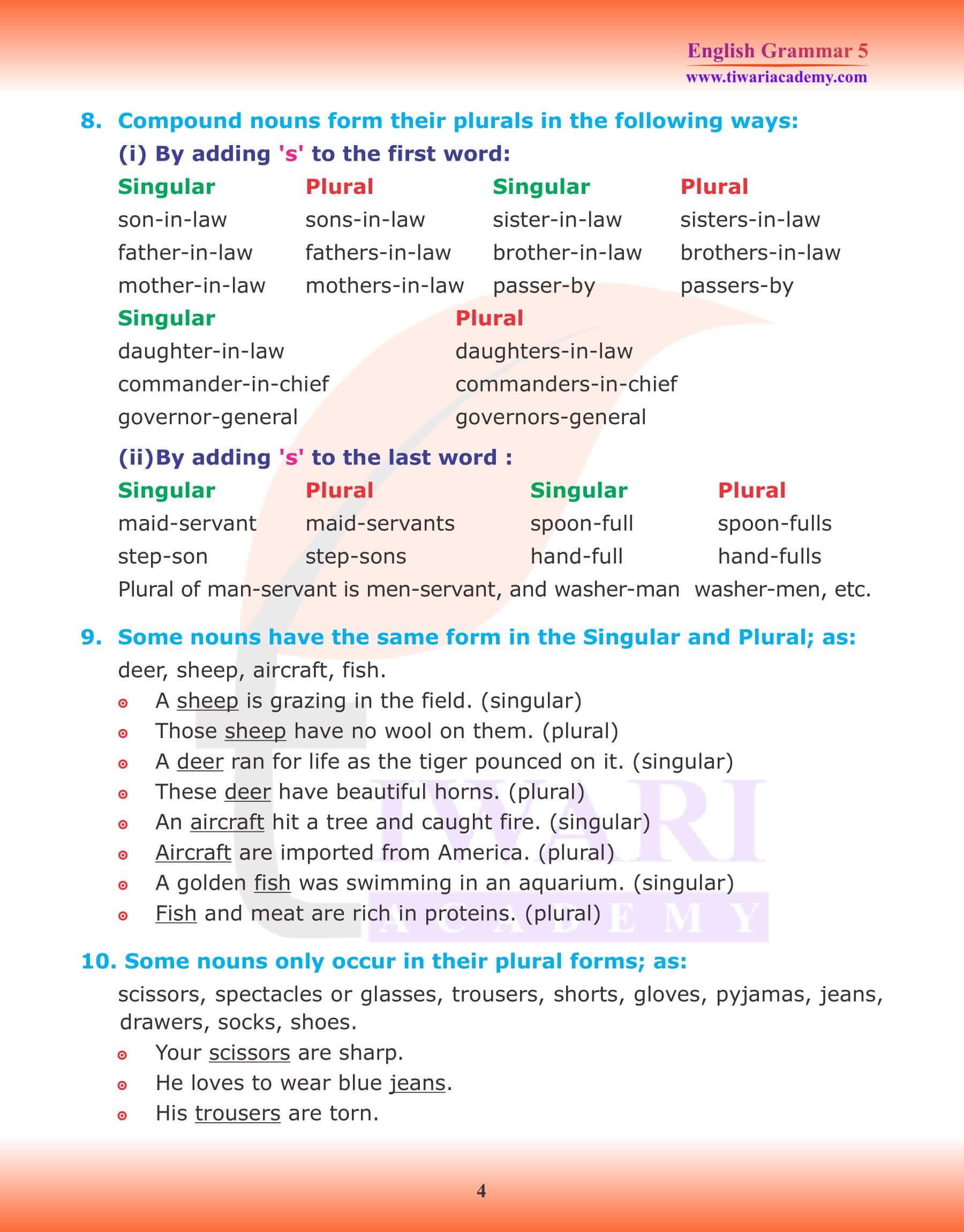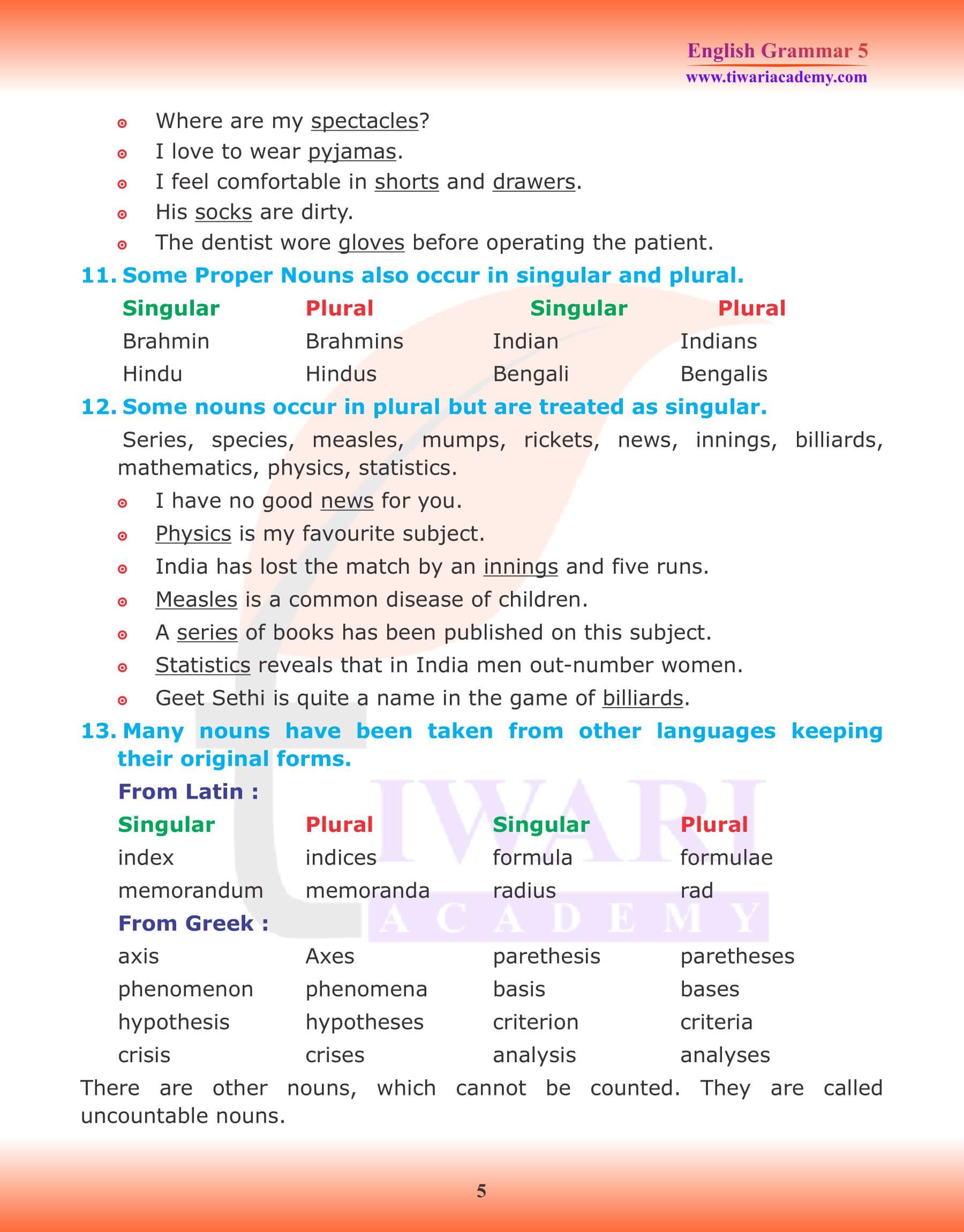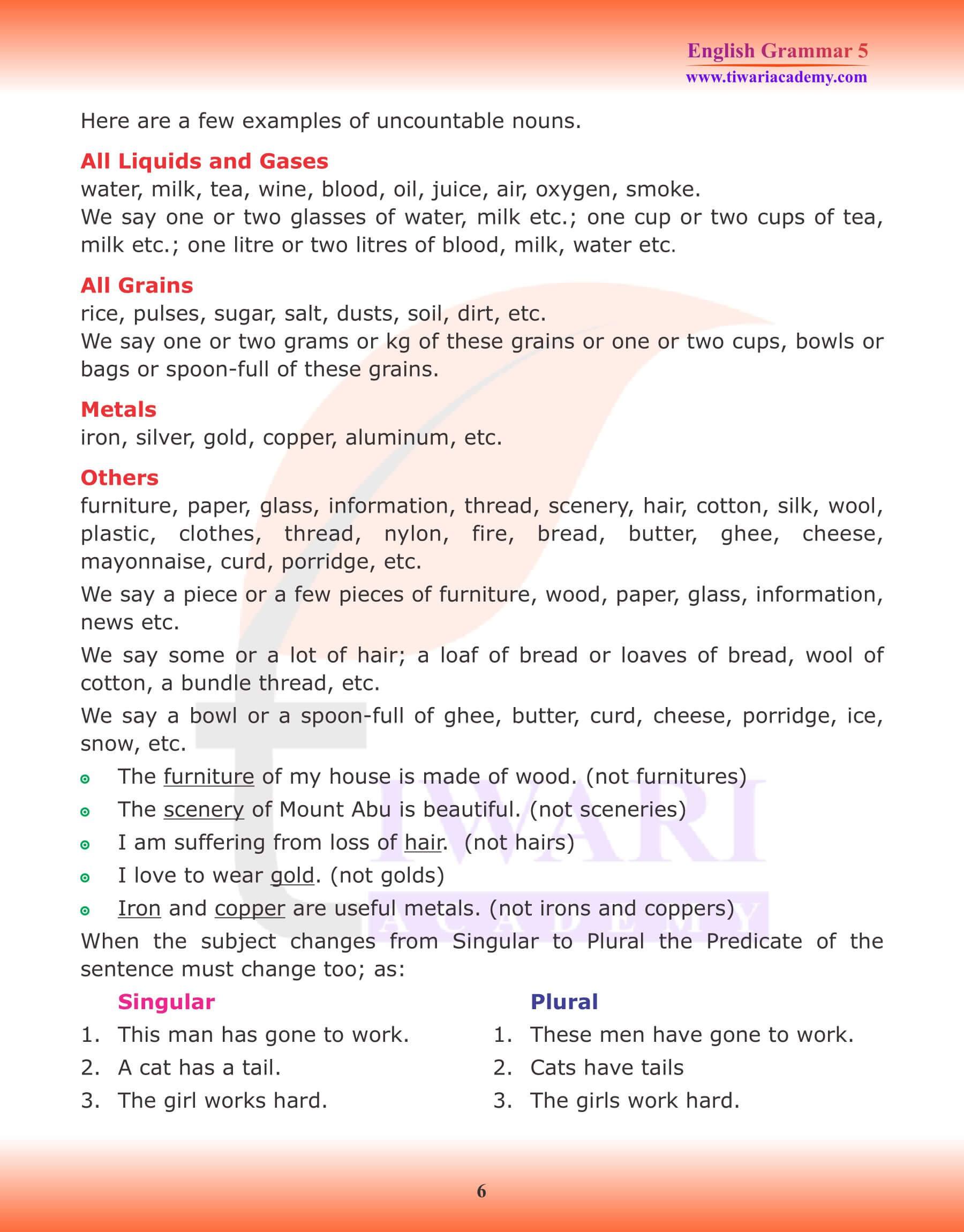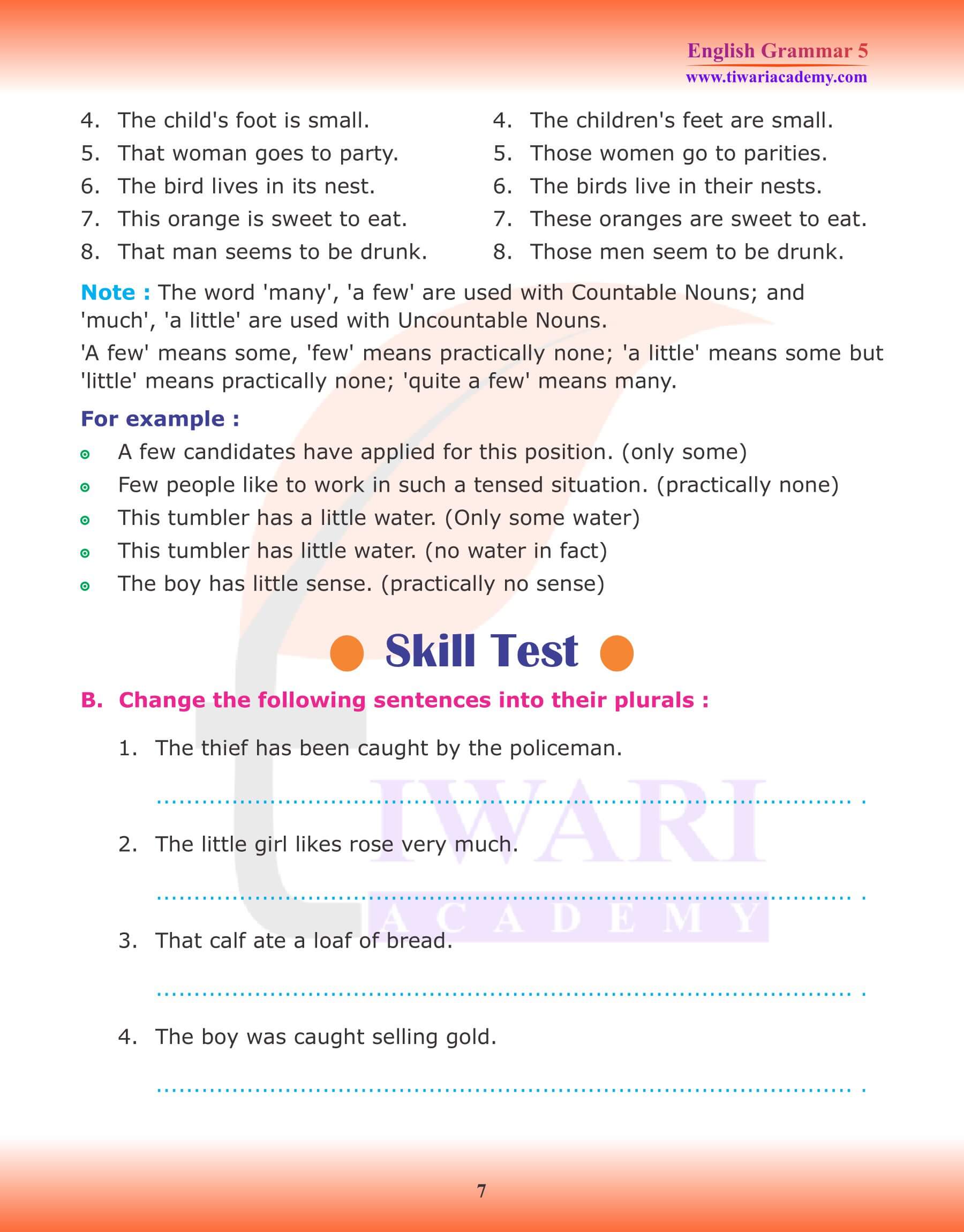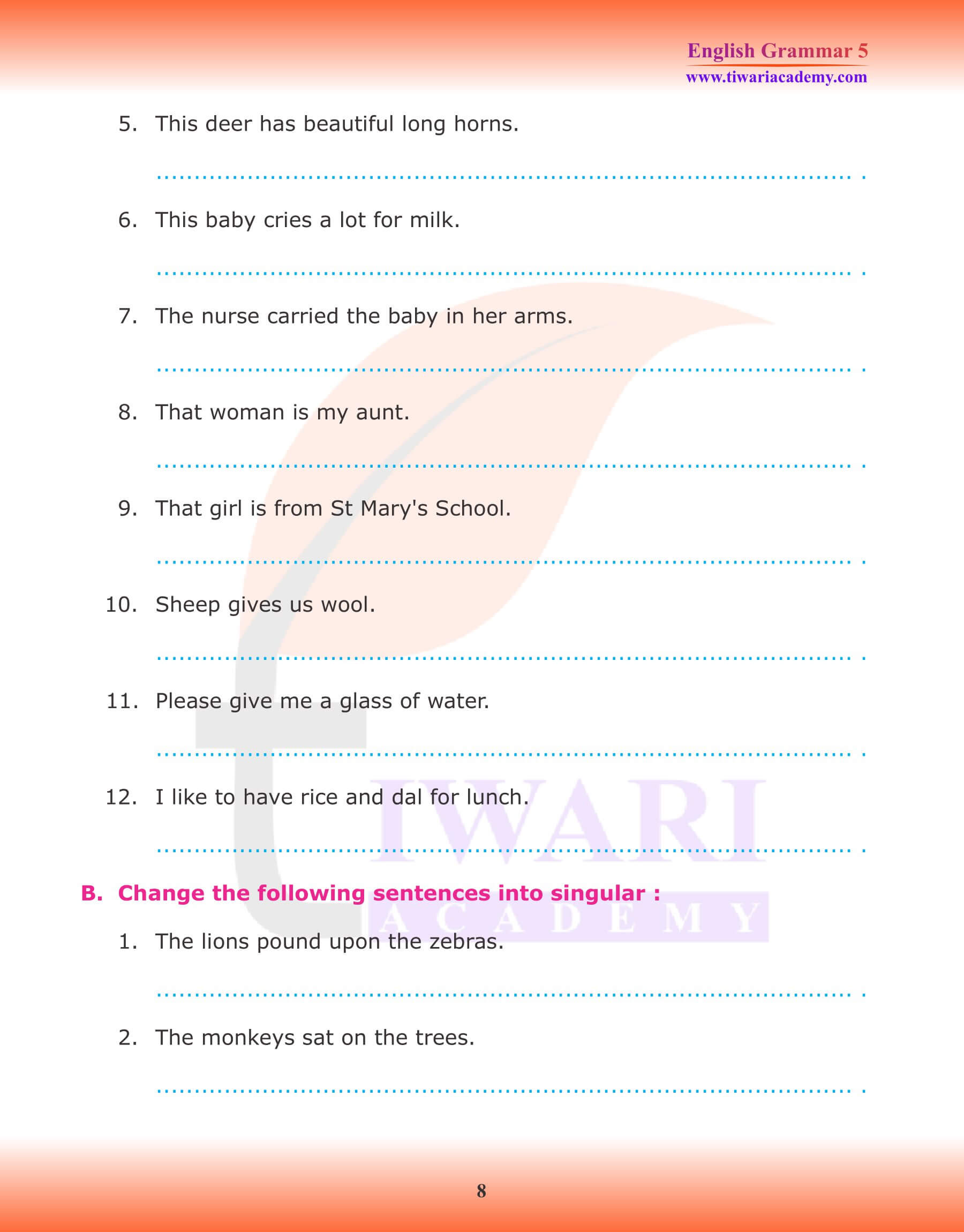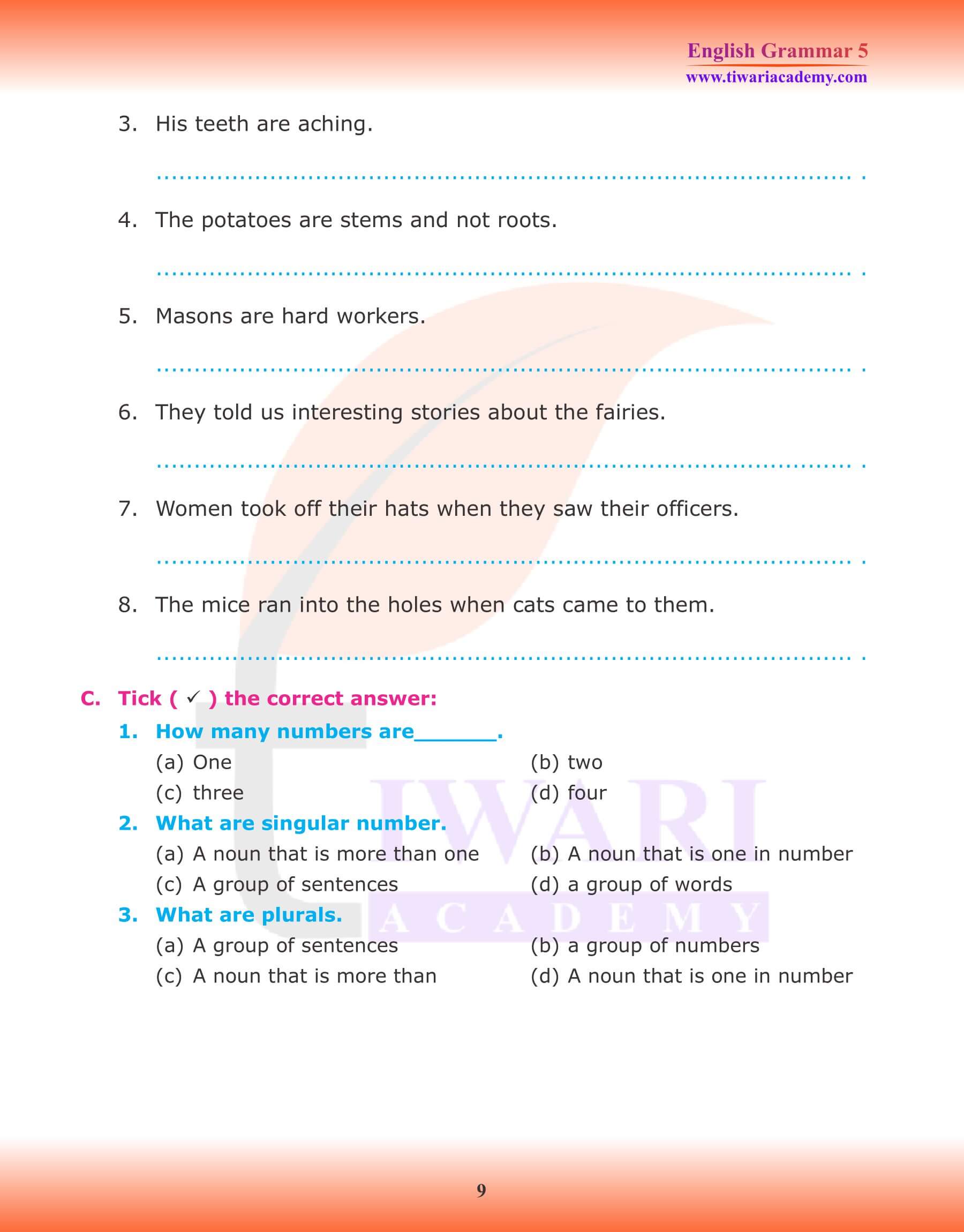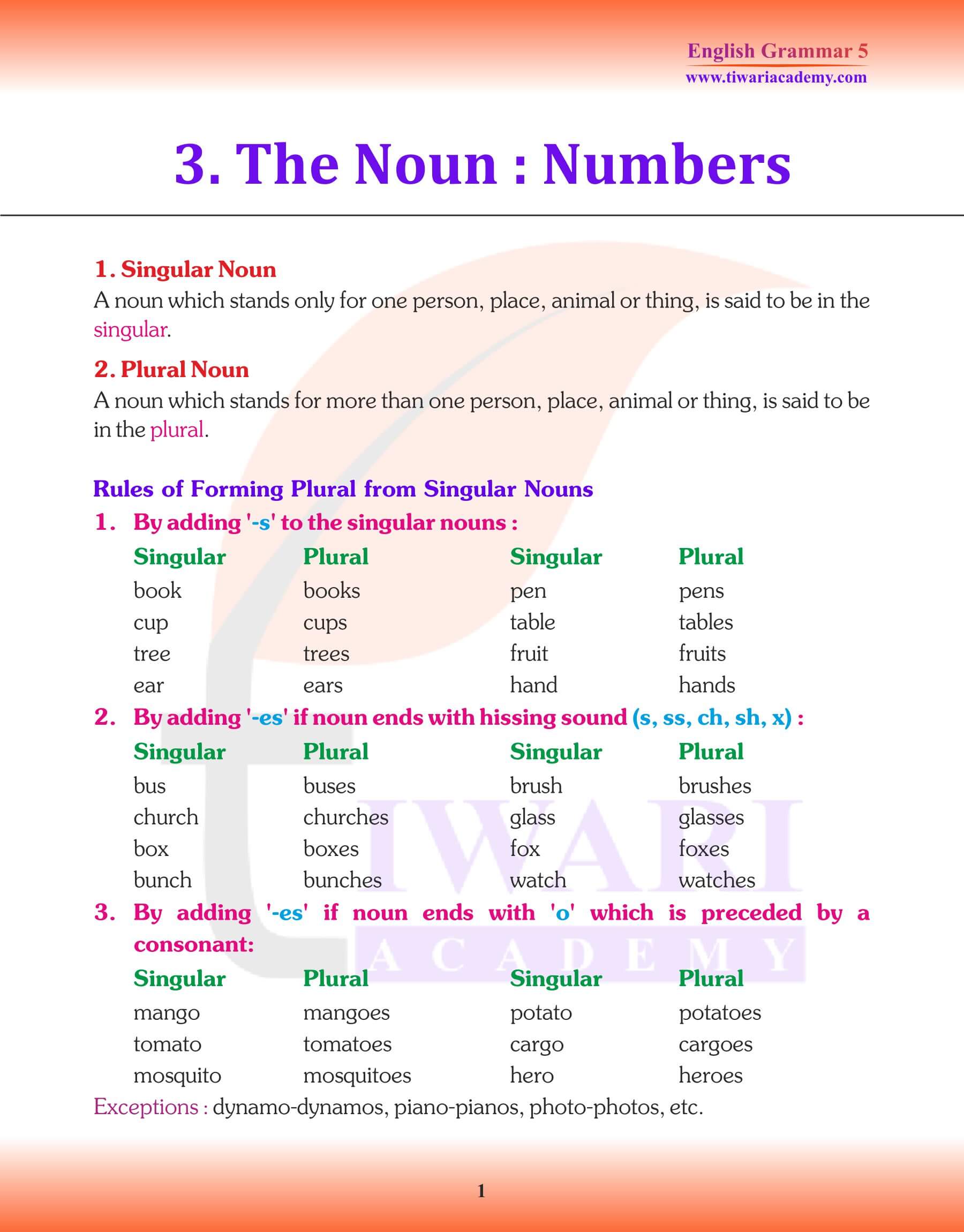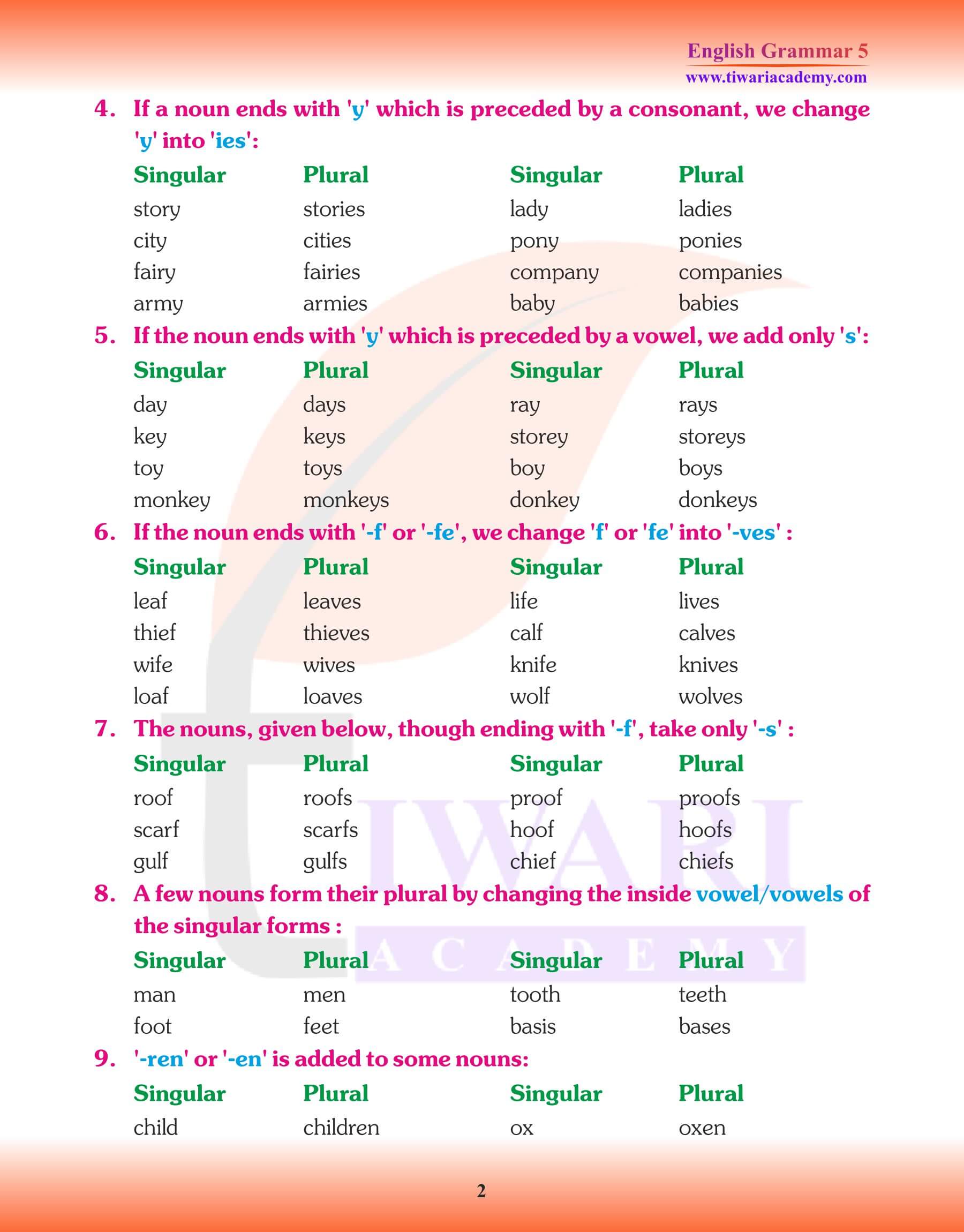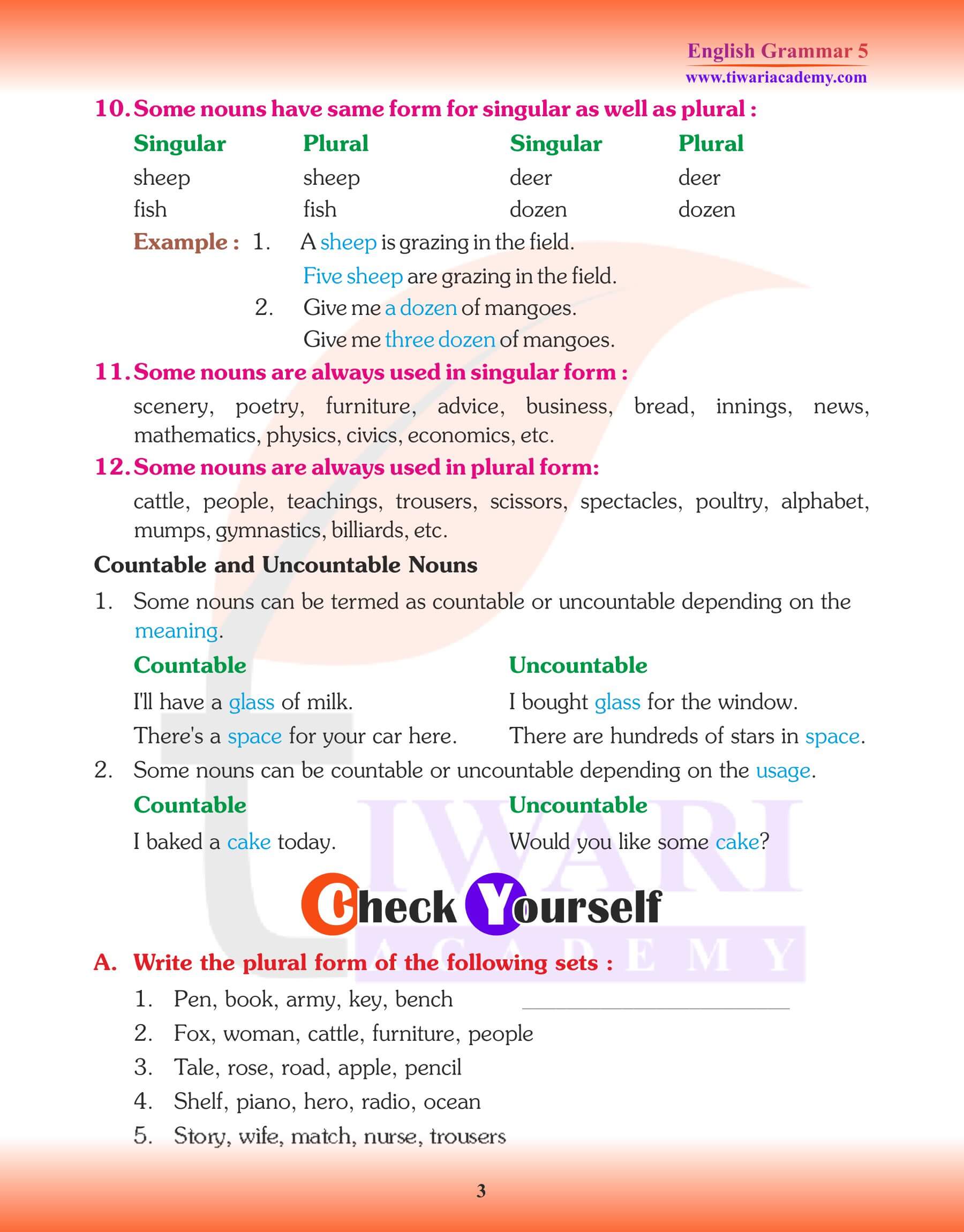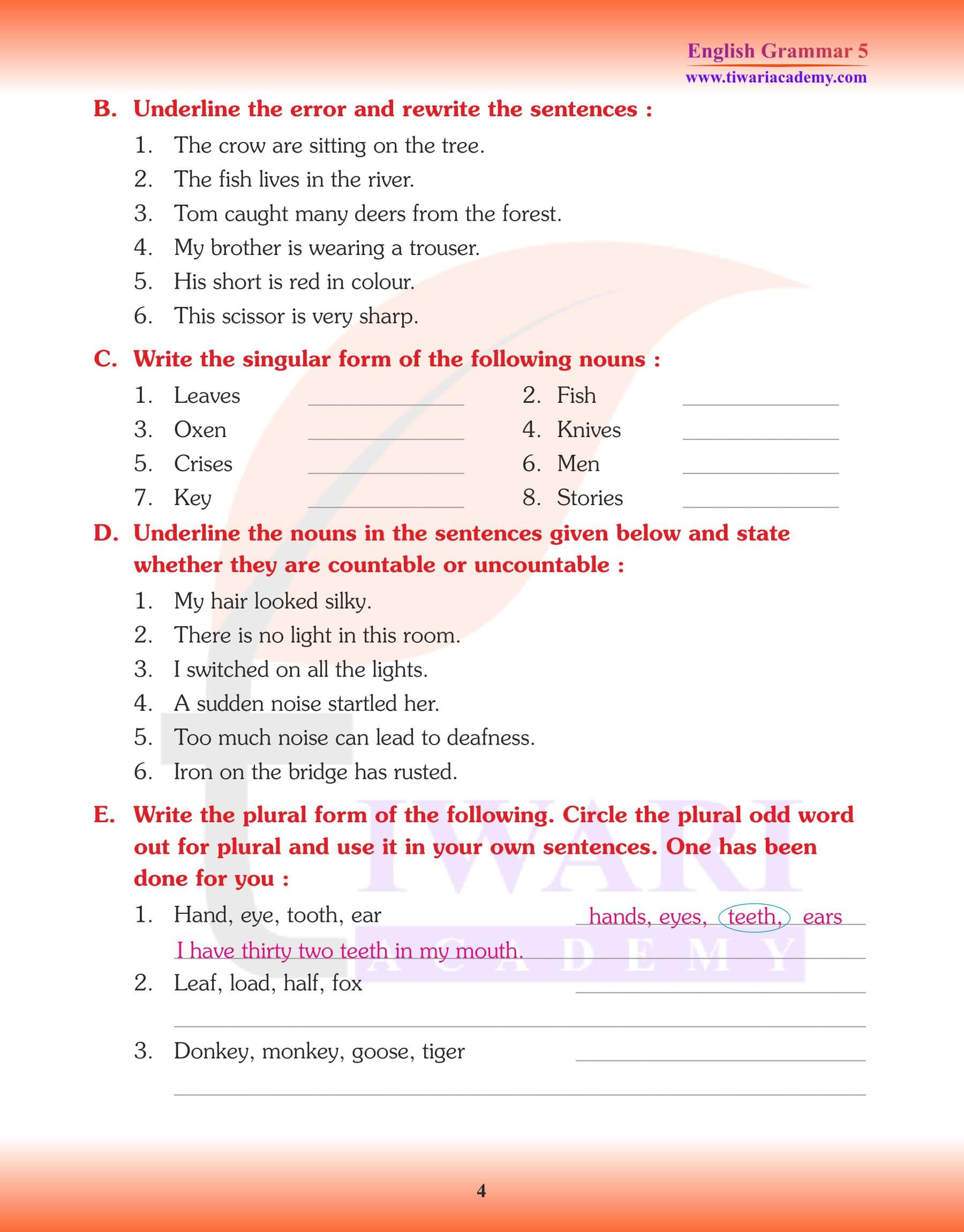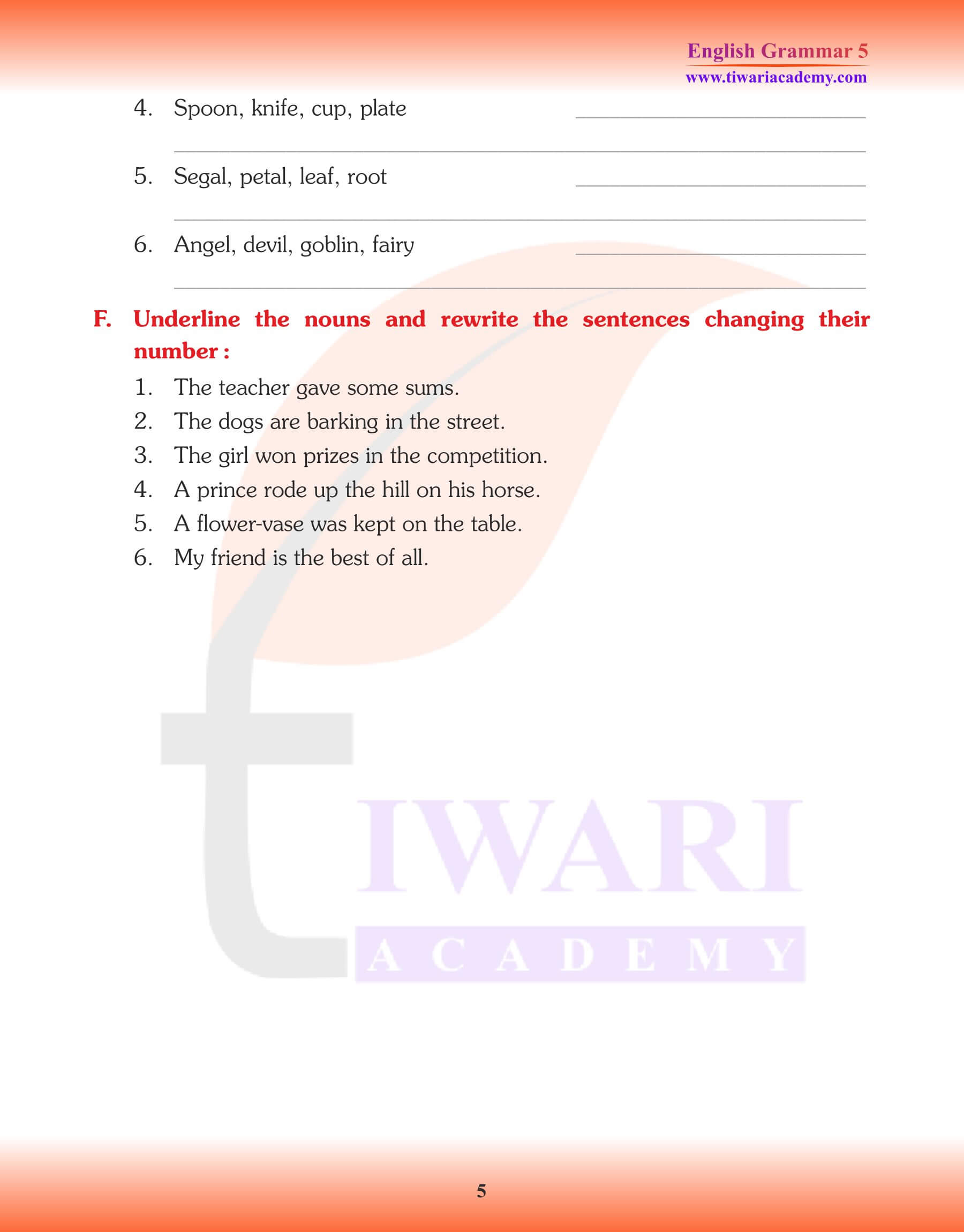NCERT Solutions for Class 5 English Grammar Chapter 3 The Noun Number for academic session 2024-25 updated for CBSE and other state board students. Here we will study about common noun and we know that all common nouns in English language are either in singular number or in plural number. All the contents are free to use without any login or password. If you are facing any problem to use these contents please contact us for help.
Learn here Class 5 English Grammar Chapter 3 The Noun Number
Class 5 English Grammar Chapter 3 The Noun Number
| Class: 5 | English Grammar |
| Chapter: 3 | The Noun Number |
Singular Noun: A noun that is one in number is said to be in the singular number e.g., a boy, a girl, a bird, a pen, a book, etc.
Plural Noun
A noun that is more than one in number is said to be in the plural number e.g., boys, girls, birds, pens, books, etc.
HOW PLURALS ARE FORMED
1. The plural of a noun can be formed by adding to the singular form of the noun; as:
| Singular | Plural |
|---|---|
| boy | boys |
| tree | trees |
| house | houses |
| pen | pens |
| plant | plants |
| lamp | lamps |
2. ‘Es’ is added to the nouns ending in ‘s’ ‘sh’ ‘ch’ or ‘x’ or ‘o’ (in some cases) to form their plurals; as:
| Singular | Plural |
|---|---|
| class | classes |
| brush | brushes |
| watch | watches |
| glass | glasses |
| dish | dishes |
3. If a noun ends in ‘y’ in its singular form and that ‘y’ follows a consonant, ‘ies’ replaces the ‘y’ to form its plural; as:
| Singular | Plural |
|---|---|
| baby | babies |
| pony | ponies |
| copy | copies |
| lady | ladies |
| body | bodies |
| reply | replies |
4. Nouns ending in ‘f’ or ‘fe’ form their plurals by replacing the ‘f’ or ‘fe’ with ‘ves’.
| Singular | Plural |
|---|---|
| wife | wives |
| thief | thieves |
| shelf | shelves |
| knife | knives |
| calf | calves |
| wolf | wolves |
Exceptions:
| Singular | Plural |
|---|---|
| dwarf | dwarfs |
| gulf | gulfs |
| handkerchief | handkerchiefs |
| hoof | hoofs |
| cliff | cliffs |
| grief | griefs |
5. A few nouns form their plurals by changing the vowels of their singular forms.
| Singular | Plural |
|---|---|
| man | men |
| foot | feet |
| mouse | mice |
| woman | women |
| tooth | teeth |
| louse | lice |
6. Compound nouns form their plurals in the following ways:
(i) By adding ‘s’ to the first word:
| Singular | Plural |
|---|---|
| son-in-law | sons-in-law |
| sister-in-law | sisters-in-law |
| father-in-law | fathers-in-law |
| brother-in-law | brothers-in-law |
| commander-in-chief | commanders-in-chief |
| governor-general governors-general | governors-general |
(ii)By adding ‘s’ to the last word:
| Singular | Plural |
|---|---|
| maid-servant | maid-servants |
| spoon-full | spoon-fulls |
| step-son | step-sons |
| hand-full | hand-fulls |
Plural of man-servant is men-servant, and washer-man washer-men, etc.
7. Some nouns have the same form in the Singular and Plural; as:
deer, sheep, aircraft, fish.
A sheep is grazing in the field. (singular)
Those sheep have no wool on them. (plural)
8. Some nouns only occur in their plural forms; as:
scissors, spectacles or glasses, trousers.
Your scissors are sharp.
His trousers are torn.
Where are my spectacles?
9. Some nouns occur in plural but are treated as singular.
Series, species, measles, mumps, rickets, news, innings, billiards, mathematics, physics, statistics.
1. I have no good news for you.
2. Physics is my favourite subject.
3. India has lost the match by an innings and five runs.
4. Measles is a common disease of children.
10. Many nouns have been taken from other languages keeping their original forms. From Latin:
| Singular | Plural |
|---|---|
| index | indices |
| formula | formulae |
| memorandum | memoranda |
| radius | radii |
From Greek:
| Singular | Plural |
|---|---|
| axis | Axes |
| parenthesis | parentheses |
| phenomenon | phenomena |
| basis | bases |
There are other nouns, which cannot be counted. They are called uncountable nouns. Here are a few examples of uncountable nouns.
All Liquids and Gases: Water, milk, tea, wine, air, oxygen, smoke.
We say one or two glasses of water, milk etc.; one cup or two cups of tea, milk etc.; one litre or two litres of blood, milk, water etc.
All Grains: Rice, pulses, sugar, salt, dusts, soil, dirt, etc.
We say one or two grams or kg of these grains or one or two cups, bowls or bags or spoon-full of these grains.
Metals: Iron, silver, gold, copper, aluminum, etc.
Others: Furniture, paper, glass, information, thread, scenery, hair, cotton, silk, wool, plastic, clothes, thread, nylon, fire, bread, butter, ghee, cheese, mayonnaise, curd, porridge, etc.
We say a piece or a few pieces of furniture, wood, paper, glass, information, news etc.
We say some or a lot of hair; a loaf of bread or loaves of bread, wool of cotton, a bundle thread, etc.
The furniture of my house is made of wood. (not furnitures)
The scenery of Mount Abu is beautiful. (not sceneries)
I am suffering from loss of hair. (not hairs)
When the subject changes from Singular to Plural the Predicate of the sentence must change too; as:
| Singular | Plural |
|---|---|
| 1. This man has gone to work. | 1. These men have gone to work. |
| 2. A cat has a tail. | 2. Cats have tails |
| 3. The girl works hard. | 3. The girls work hard. |
| 4. The child’s foot is small. | 4. The children’s feet are small. |
| 5. That woman goes to party. | 5. Those women go to parties. |
| 6. The bird lives in its nest. | 6. The birds live in their nests. |
Note: The word ‘many’, ‘a few’ are used with Countable Nouns; and ‘much’, ‘a little’ are used with Uncountable Nouns. ‘A few’ means some, ‘few’ means practically none; ‘a little’ means some but ‘little’ means practically none; ‘quite a few’ means many.
For example:
A few candidates have applied for this position. (only some)
Few people like to work in such a tensed situation. (practically none)
This tumbler has a little water. (Only some water)
This tumbler has little water. (no water in fact)
The boy has little sense. (practically no sense)
In which noun singular and plural numbers are used in chapter 3 Grammar Class 5?
All common nouns in English language are either in singular number or in plural number.
What is the change in predicate when subject changes from singular to plural Class 5 English Grammar chapter 3?
When the subject changes from Singular to Plural the Predicate of the sentence must change too; as:
Ex. 1. This man has gone to work. (singular)
These men have gone to work. (plural)
